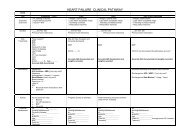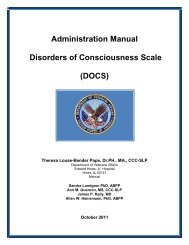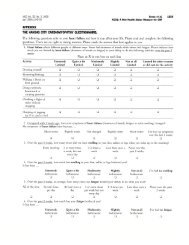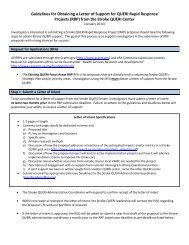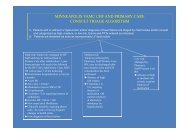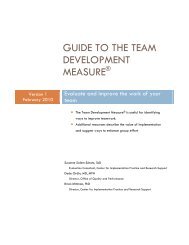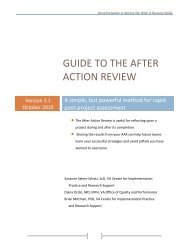The Veteran Supported Education Service Treatment Manual: VetSEd
The Veteran Supported Education Service Treatment Manual: VetSEd
The Veteran Supported Education Service Treatment Manual: VetSEd
Create successful ePaper yourself
Turn your PDF publications into a flip-book with our unique Google optimized e-Paper software.
i. Self-Direction<br />
<strong>Veteran</strong>s are in the driver seat and determine the roadways and byways they take in their<br />
journey of recovery. As a peer <strong>VetSEd</strong> provider, you promote <strong>Veteran</strong>s‘ choice, decisionmaking<br />
and autonomy as they pursue their educational goals.<br />
ii.<br />
Individualized and <strong>Veteran</strong>-Centered<br />
As a peer <strong>VetSEd</strong> provider it may be tempting to tell <strong>Veteran</strong>s what to do based on your<br />
prior successes with other <strong>Veteran</strong>s. For instance, if you helped one returning <strong>Veteran</strong> get<br />
into the local community college, it may be tempting to track other <strong>Veteran</strong>s to this<br />
school given your prior success. Yet, if your <strong>VetSEd</strong> services are truly <strong>Veteran</strong>-centered<br />
you will be working with each <strong>Veteran</strong> to identify their unique strengths, personal assets<br />
and preferences. Further, you will recognize that not all returning <strong>Veteran</strong>s are alike.<br />
Rather, <strong>Veteran</strong>s differ in terms of their mental health needs, military experiences,<br />
cultural background, and age, to name but a few areas of uniqueness. Taking time to get<br />
to know each <strong>Veteran</strong> on your <strong>VetSEd</strong> caseload will help you provide individualized<br />
services.<br />
iii.<br />
Empowerment<br />
Empowerment allows <strong>Veteran</strong>s to not only be in the driver‘s seat of their recovery, but<br />
also have increased agency about where they ultimately go. SAMSHA describes<br />
empowerment as a process through which ―an individual gains control of his or her<br />
destiny and influences the organizational and societal structures in his or her life (2006).‖<br />
You can promote empowerment among <strong>Veteran</strong>s participating in <strong>VetSEd</strong> by: a) offering<br />
<strong>Veteran</strong>s a spectrum of options when faced with decisions; b) allowing and encouraging<br />
<strong>Veteran</strong>s to participate in all decisions related to their <strong>VetSEd</strong> services (including<br />
decisions related the administration and funding of <strong>VetSEd</strong> services); and c) encouraging<br />
<strong>Veteran</strong>s to partner with other <strong>Veteran</strong>s on and off campus to advocate for <strong>Veteran</strong><br />
interests, needs and perspectives.<br />
iv.<br />
Holistic<br />
Though <strong>VetSEd</strong> is focused mostly on educational aspirations and related goals, for<br />
<strong>VetSEd</strong> services to be successful they need to consider the <strong>Veteran</strong>‘s whole life. <strong>Veteran</strong>s<br />
do not gain admission to school, matriculate and graduate in a vacuum. Rather, each<br />
<strong>Veteran</strong>‘s mind, body, spirit and connection to community supports play a notable role in<br />
81 | P a g e



